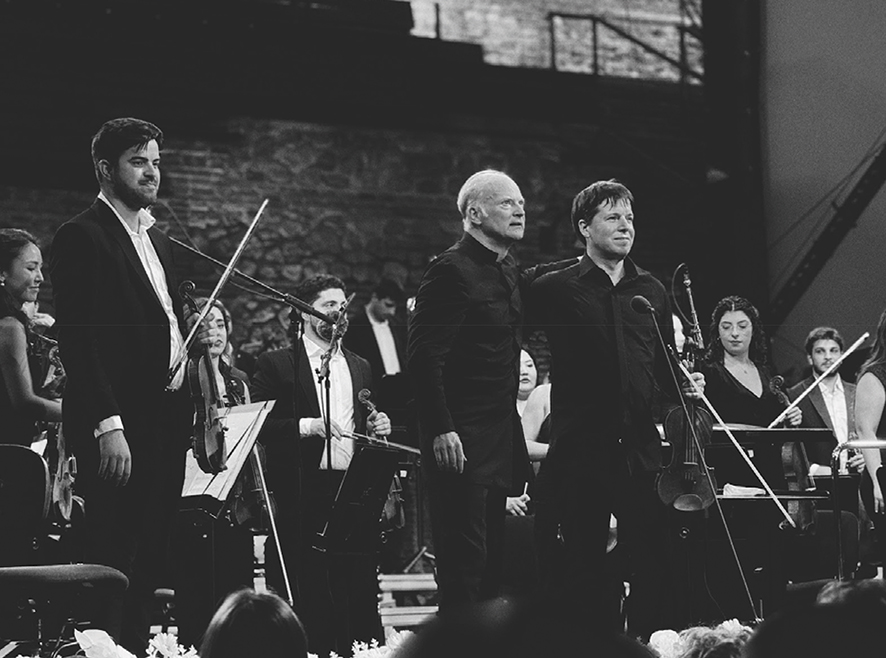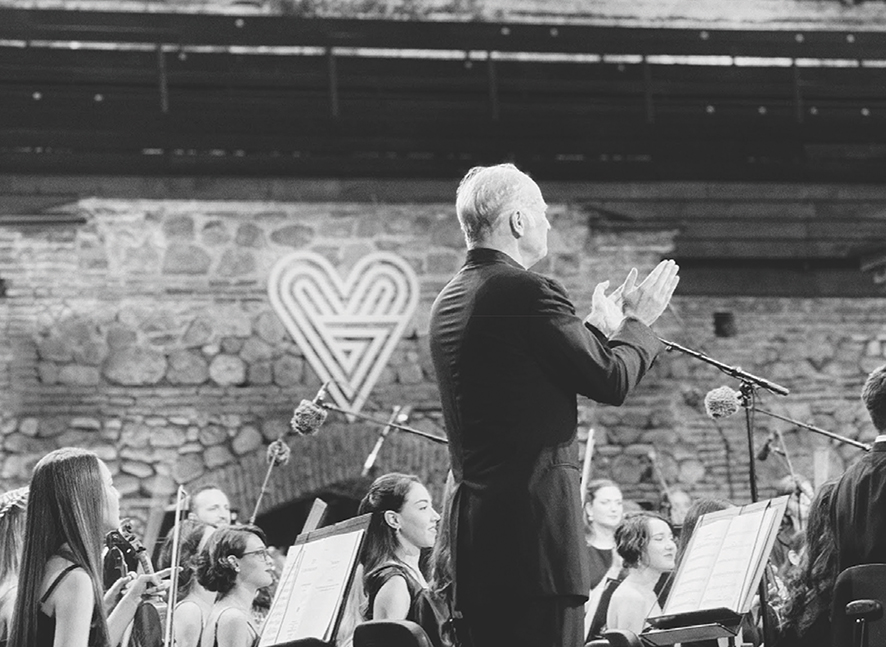In the scenic heart of Georgia’s wine country, where the gentle hills of Kakheti cradle the storied Tsinandali Estate, the Tsinandali Festival has emerged as a cultural beacon, illuminating the region’s growing significance in the global classical music landscape. This year’s festival, a celebration of unity and artistic excellence, reached new heights with a spellbinding concert that brought together some of the most celebrated names in classical music.
Under the velvet sky of a late summer evening, the Tsinandali Amphitheater—a marvel of acoustical design set amidst the estate’s lush gardens—played host to a performance that will undoubtedly be etched into the annals of Georgian cultural history. The Pan-Caucasian Youth Orchestra, under the baton of the illustrious Gianandrea Noseda, delivered a masterclass in orchestral performance, featuring violin virtuoso Joshua Bell and soprano sensation Chen Reiss. The program, an exquisite pairing of Henryk Wieniawski’s Violin Concerto No. 2 in D Minor, Op. 22 and Gustav Mahler’s Symphony No. 4 in G Major, offered a profound exploration of the human spirit’s complexities—both its fiery passions and its yearning for celestial peace.

A Stage Set by History and Nature: The Tsinandali Festival
Before delving into the intricate details of the performance, it is essential to appreciate the Tsinandali Festival’s context and its rapidly ascending stature in the global classical music scene. Established as a platform for cultural exchange and artistic excellence, the festival, which opened on August 31 and continues until September 8 this year, has quickly become one of the most anticipated events on the international classical music calendar.
The Tsinandali Estate itself is a site of immense historical and cultural significance. Once the home of the 19th-century Georgian aristocrat and poet Alexander Chavchavadze, the estate has long been a crossroads of Eastern and Western cultural influences. The estate’s conversion into a world-class venue for classical music, while preserving its historical charm, symbolizes Georgia’s commitment to fostering cultural dialogue and its aspiration to serve as a cultural bridge between Europe and Asia.
This year’s festival is particularly notable for its emphasis on nurturing young talent through the Pan-Caucasian Youth Orchestra, an ensemble comprising the finest young musicians from across the Caucasus region. This initiative not only highlights the region’s rich musical heritage, but also fosters unity among the diverse cultures of the Caucasus, underscoring music’s role as a universal language.

Virtuosity Embodied: Joshua Bell and Wieniawski’s Violin Concerto No. 2
The first half of the evening belonged to the incomparable Joshua Bell, whose performance of Wieniawski’s Violin Concerto No. 2 was nothing short of revelatory. Wieniawski, a composer renowned for his virtuosic demands on the violin, created a work that is as technically challenging as it is emotionally rich. Bell’s interpretation was a masterclass in balancing these dual demands, delivering a performance that was both technically flawless and deeply expressive.
From the concerto’s opening Allegro moderato, Bell’s violin soared with a clarity and brilliance that immediately captivated the audience. The intricate interplay between the soloist and the orchestra, under Noseda’s meticulous direction, brought out the conversational nature of the piece, with Bell’s violin lines weaving seamlessly in and out of the orchestral fabric. His execution of the virtuosic passages, filled with rapid runs and complex double stops, was nothing short of awe-inspiring, yet what truly set his performance apart was his ability to infuse each note with emotion, creating a narrative that spoke directly to the listener’s soul.
‘The Romance: Andante non troppo,’ the concerto’s lyrical second movement, saw Bell’s violin take on a more introspective tone. His sound, warm and inviting, filled the amphitheater with a sense of intimacy, as if he were sharing a personal story with each member of the audience. The movement’s cantabile lines, played with exquisite phrasing and a delicate touch, resonated with the natural acoustics of the open-air venue, creating a moment of profound beauty that felt almost suspended in time.
In the final movement, ‘Allegro con fuoco – Allegro moderato (à la Zingara),’ Bell unleashed the full range of his technical prowess. The movement’s Zingara theme, characterized by its lively rhythms and fiery character, was brought to life with an energy and precision that left the audience breathless. Bell’s performance here was a dance of virtuosity, his fingers flying across the fingerboard with dazzling speed, yet never losing the sense of joy and spontaneity that defines the piece. The orchestra, perfectly in sync with Bell, provided a vibrant and dynamic accompaniment, matching his intensity at every turn.

The Sublime and the Transcendent: Mahler’s Symphony No. 4
Following the interval, the concert transitioned from the virtuosic intensity of Wieniawski to the contemplative grandeur of Mahler’s Symphony No. 4 in G Major. This symphony, one of Mahler’s most accessible yet profoundly philosophical works, explores the themes of innocence, death, and the afterlife, culminating in a vision of heaven as seen through the eyes of a child.
Gianandrea Noseda, one of the most sought-after conductors of our time, brought his deep understanding of Mahler’s complex emotional landscape to the fore, guiding the Pan-Caucasian Youth Orchestra through a performance that was both deeply moving and meticulously crafted. Noseda’s interpretation was marked by a profound sensitivity to the symphony’s shifting moods, from the pastoral serenity of the opening movement to the otherworldly tranquility of the finale.
The first movement, ‘Bedächtig. Nicht eilen,’ opened with a simple yet evocative theme, played with a sense of lightness and grace that belied the deeper undercurrents of the music. The orchestra’s woodwinds, in particular, shone in this movement, their clear and bright tones blending beautifully with the strings to create a soundscape that was both lush and transparent. Noseda’s pacing was deliberate, allowing the music to unfold naturally, with each phrase building on the last to create a sense of narrative progression.
In the second movement, ‘In gemächlicher Bewegung. Ohne Hast,’ Mahler introduces the spectral figure of ‘Freund Hein,’ symbolized by a solo violin tuned a whole tone higher than usual. This eerie, otherworldly sound was played with haunting beauty by the concertmaster, whose performance added a layer of mystery and foreboding to the music. Noseda’s handling of this movement was masterful, balancing the whimsical and the macabre with a deft touch that kept the audience on the edge of their seats.
The third movement, ‘Ruhevoll (Poco adagio),’ was the emotional heart of the symphony. This slow movement, with its deep sense of serenity and contemplation, was played with a warmth and richness that filled the amphitheater with a palpable sense of peace. The strings of the Pan-Caucasian Youth Orchestra were particularly moving here, their sound enveloping the audience in a warm embrace that seemed to merge with the surrounding landscape. Noseda’s interpretation was deeply introspective, allowing the music to speak directly to the listener’s heart, evoking a sense of spiritual calm that was both powerful and healing.
The final movement, ‘Sehr behaglich,’ brought the symphony to a close with the introduction of the soprano soloist, Chen Reiss. Singing the text of the Wunderhorn song ‘Das himmlische Leben,’ Reiss’s voice was pure and radiant, perfectly capturing the childlike innocence and joy of Mahler’s vision of heaven. Her performance was a revelation, blending seamlessly with the delicate orchestration to create a moment of transcendent beauty that left the audience spellbound. Noseda’s conducting in this movement was marked by a gentle restraint, allowing Reiss’s voice to take center stage while the orchestra provided a subtle and supportive accompaniment.
Tsinandali as a Symbol of Unity and Artistic Excellence
The Tsinandali Festival, with its unique setting and world-class performers, offered an unforgettable musical experience that transcended the boundaries of the concert hall. The combination of Wieniawski’s fiery concerto and Mahler’s contemplative symphony created a program that explored the full range of human emotion, from virtuosic brilliance to spiritual peace.
Gianandrea Noseda’s direction, coupled with the talents of Joshua Bell and Chen Reiss, brought these works to life with a freshness and vitality that resonated deeply with the audience. The Pan-Caucasian Youth Orchestra, composed of young musicians from across the region, played with a maturity and sensitivity that belied their years, making a powerful statement about the unifying power of music.
In the tranquil surroundings of the Tsinandali Estate, where the boundaries between the stage and the natural world seemed to blur, this concert was a testament to the enduring power of classical music to evoke, inspire, and transform.
By Ivan Nechaev













